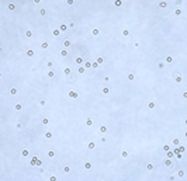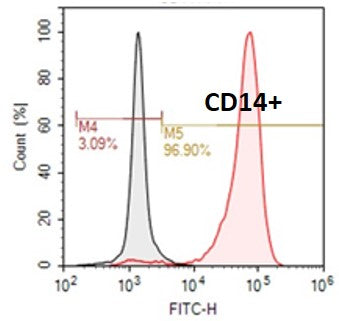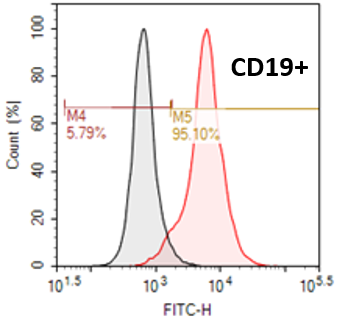Human Cord Blood CD3+ Pan T Cells
Most T cell lineages express surface protein CD3, which is made of invariant subchains belonging to the immunoglobulin superfamily. CD3 is a multimeric protein complex, which is composed of four distinct chains (CD3g, CD3d and two CD3e). CD3 on the cell surface associated with the T-cell antigen receptor (TCR) functions in the signaling transduction cascade that originates when a peptide - MHC ligand binds to the TCR.
These T cells can be subdivided further into NK cells, CD8+ cytotoxic T cells and CD4+ helper T cells. T cells are used to perform research in immunology as well as oncology and infectious diseases.
Our Cord Blood CD3+ Pan T Cells are isolated from cord blood mononuclear cells by immunomagnetic selection. All cord blood is collected in Citric Phosphate with Dextrose Buffer (CPD) from fully consented IRB approved donors.

Figure 1. Flow cytometric analysis showed that >90% of the cells are CD3+.
In immunology, the CD3 (cluster of differentiation 3) T-cell co-receptor helps to activate both the cytotoxic T-Cell (CD8+ naive T cells) and also T helper cells (CD4+ naive T cells). It consists of a protein complex and is composed of four distinct chains. In mammals, the complex contains a CD3γ chain, a CD3δ chain, and two CD3ε chains. These chains associate with a molecule known as the T-cell receptor (TCR) and the ζ-chain (zeta-chain) to generate an activation signal in T lymphocytes. The TCR, ζ-chain, and CD3 molecules together constitute the TCR complex.

Figure 2. The T-cell receptor complex with TCR-α and TCR-β chains (top), ζ-chain accessory molecules (bottom) and CD3 (represented by CD3γ, CD3δ and two CD3ε). In the immunological synapse, the stimulation of TCR and CD28 by the corresponding receptors on the antigen-presenting cell (APC) trigger the activation of different signaling pathways that lead to the induction of the immune response. T cells are activated by binding of the major histocompatibility complex (MHC)/antigen complex (the yellow rhombus represents the antigen) to TCR.
Related Products:
Our Product was utilized in:
- Choi, Sang-Heon, Jong-Gu Choi, and Sang-Suk Lee. "Injection Effect of Anti-CD3 Monoclonal Antibody on Primo Vessel in Lymph Vessel of Rabbit with Lipopolysaccharide-Induced Inflammation." Journal of Acupuncture and Meridian Studies 15.1 (2022): 37-42. https://doi.org/10.51507/j.jams.2022.15.1.37









